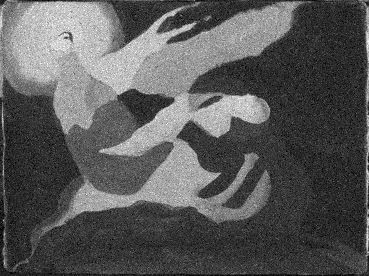Dosing Culture, Part One
What we get from cultural reception now is not so much an “experience” or a single coherent “work of art” as an endless series of doses.

This essay is an excerpt from a longer version to be published in Cured Quail vol 2.
The overdevelopment of the division of labor in society lives on the immaturity of the ruled. The more complex and sensitive the social, economic, and scientific mechanism, to the operation of which the system of production has long since attuned the body, the more impoverished are the experiences of which the body is capable. The elimination of qualities, their conversion into functions, is transferred by rationalized modes of work to the human capacity for experience, which tends to revert to that of amphibians. The regression of the masses today lies in their inability to hear with their own ears what has not already been heard, to touch with their hands what has not previously been grasped; it is the new form of blindness which supersedes that of vanquished myth.
Adorno and Horkheimer, Dialectic of Enlightenment
Sublimation, Diversion and Dissociation
In Civilization and its Discontents, Freud discusses various defenses, or ‘techniques of life,’ which human beings have developed to contravene our unhappiness. For Freud, discontent is inevitable. Civilization requires the repression of our congenital tendency toward unbridled pleasure seeking, and pleasure is our only source of happiness. Culture is considered from two basic perspectives in his discussion. The first is as a diversion. Culture provides momentary sensual pleasure, a release from the pressures of reality. Freud compares culture as diversion to the use of ‘chemical substances,’ found in one form or another in every society, which regulate emotional economies, promote cohesion and suppress dissent.
Freud subsumes the second perspective on culture, together with art, science and philosophy, under the heading of ‘sublimation.’ Sublimation is another form of diversion, but a deeper and more lasting one. It is a displacement of the drives, as opposed to a mere distraction or pseudo-satisfaction, into higher yet less intense forms of pleasure. It is as if through sublimation a substance normally toxic in its pure form is able to combine with something from the outside world. In the process, it becomes a safer compound. Neither diversion nor sublimation solve our fundamentally problematic existence as pleasure fiends in the wrong world, but the latter at least contributes to a strengthening of the self over time.
It is to Freud’s credit that he refuses to restrict culture to sublimation alone, making sure not to neglect the ‘lower’ forms that are equally important in our psychic and social economy. This is important for any contemporary study of culture because today, sublimation as a cultural outlet is increasingly supplanted by diversion, which infects even those areas previously believed to be bastions of serious pursuits. What we often get from culture now can only be called an ‘experience’ by stretching the meaning of the term. It is too impoverished even for that abstract criteria. It is more like an endless series of doses.
We can recognize this in the transformation of the word itself. Culture is just as likely to signify YouTube videos, live streams, podcasts, tweets, serialized TV, Twitch streams, pop songs, shareable content on platforms like Instagram or TikTok, and corporate narrative franchises as the history of literature, religion and ritual, or visual art. We often speak now simply of ‘media,’ an elision that seems to hit upon something objective: the relationship of objects of culture to cultivation has been liquidated, replaced by marketing, algorithmic standardization, commodification, and pseudo-personalization. It is now a cycle of ‘content production’ and mindless consumption.
Cultural objects within capitalism have always been commodities, and as such they are underpinned by economic imperatives and forms of technology that, by serving these imperatives, shape art’s inner qualities and modes of reception. As commodities that are meant to capture our minds, they also have the power, compounded over time, to structure our desires and determine the limits of our experience, our modes of thought, and our capacities for reflection. Put simply, they begin to change what it means to be a subject just as religion, which it has replaced, once did.
Culture now comes at us in an endless stream. Our task is not interpretation, but simply to prepare ourselves to consume more without digesting anything. To aid this effortless internalization, content becomes smooth, rigid and textureless, and it just keeps coming. The process of consumption, ceaseless as it is, must be made so habitual and frictionless that nothing can possibly stick. Culture no longer cultivates. It is not meant to. The objects foisted upon us no longer allow for that kind of engagement.
Dosing culture is merely the latest iteration of the culture industry, which long ago supplanted sublimation culture as the latter’s social, institutional and intellectual foundations eroded. In the American case, so-called elite culture has always been restricted to a small minority. In many respects, dosing culture is simply an intensification of the tendencies of standardization, pseudo-personalization and psychological regimentation that have been hallmarks of mass culture since its beginning.
Because labor-power in capitalism is a commodity, our mental, emotional and bodily lives are commodified through work. In a basic sense, while we are at work we are no longer in possession of ourselves. Around the midcentury, theorists like C. Wright Mills and Harry Braverman highlighted the specific psychological effects of this regimentation, which never applied strictly to bodies but also to our minds, our psychologies, our inner behavior, our self-concepts. The Frankfurt School brought to these topics the recognition that the logic of subsumption is not restricted to our time at work. The culture industry was thus theorized as the sphere of extensions of commercial imperatives into free time.
Has digital culture altered this logic in any way, or has it simply intensified it? Dosing culture is clearly a continuation of the ideological functions of mass culture: reification and psychological integration remain primary; to instill the feeling that the world cannot possibly be other than it is. But it is possible that dosing culture achieves this aim in new ways, which might be significant for any contemporary theory of subjectivity.
How should we outline this development? If traditional ‘bourgeois culture’ (at least in theory) was built for sublimation, and early forms of analog mass culture replaced sublimation with diversion, dosing culture can perhaps be said to have gone a step further and developed a total cultural system of dissociation. Or, as it has been put elsewhere, the history of the culture industry, believed by the theorists of the Frankfurt School to have been powerful enough to fundamentally change subjectivity in modern society, is the history of the transformation of neurotic subjects into properly psychotic ones. “Rather than drives and emotions pressing forth from the inside, drives and emotions are cut off from oneself and participate in the construction of a claustrophobic and paranoid reality surrounding us, so that emotional life and reality become so fused as to become indistinguishable.”
Dosing culture is a system built to elicit psychotic-like mental functioning, tendentially cutting us off from reality and liquidating our capacities for thought. What dosing culture manages, as a total cultural system, is to replace older forms of aesthetic engagement, even the relatively superficial ones of analog mass culture, with a total psychotic system, a constant flow of undigested objects, an inescapable, claustrophobic loop of integration.
The symptoms are numerous: the sense of timelessness and lack of development; the transition from boredom to manic activity, or in some cases their combination in a single activity; the suffusion of consciousness with a sense of sterility and stasis despite the constant flow of new content; the constant sense of distraction or pseudo-engagement—all these qualities articulate the general sense of a culture that is cut off from our inner depths even as it manages to dominate consciousness, insinuating itself into daily behavior, prevalent attitudes and mental functioning during our free time and at work.
This change has a number of social, political and psychological ramifications. In psychological terms contemporary culture, even more so than older forms of mass culture, requires the subsumption of our experiential awareness and mental functioning to industrial technology, leading to manifestly negative psychological outcomes. The rise of TV and radio in the twentieth century certainly led to widespread conventionalism, but digital culture literally makes people ill—anxious, depressed, paranoid. Almost all of its qualities follow from its tendency to liquidate our capacity for complex thought, to replace reality contact with projection, paranoia and mania.
I will describe dosing culture’s psychotic tendencies in greater detail below, but for now it is worth briefly mentioning two of its most important political ramifications. In psychotic life, nothing develops. The sense of time atrophies. Digital culture spoils both our capacity for historical experience as well as our ability to feel in art the sense that another world is possible. Authentic art throughout history has served as a container for the collective longing for a world not based in domination. This element disappears in dosing culture. The culture industry was always ‘positivist,’ made up of forms, contents and images that largely refuse to go beyond the status quo. Dosing culture works by further severing the link between aesthetic experience and non-standard experience.
This is achieved in formal terms through the destruction of relationships which previously made meaning and development possible: the relationships inside an artwork itself; the reciprocal relationship between the work’s development and the subject’s development, which extends to the relationship between aesthetic competence and psychological maturity; and finally, perhaps most importantly, the relationship between the work and historical meaning. Dosing culture simply does not allow for any meaningful sense of time. Its dissociative tendencies promote historical amnesia to an extreme degree. Our minds tend to shut off as we consume it, to the point where what has happened even the day before disappears from awareness.
This process of formal flattening is made possible by extreme forms of technical regimentation. Not only does dosing consist mostly of impoverished contents ripped from everyday life, but in formal terms it is a product of severing the tie between form and content, technique and inner development. Form is replaced by the proprietary technology of the platform, software that controls into the minutest detail how you produce, share and experience work, and algorithms that constantly filter what you are able to see. Spontaneity is replaced by platform and algorithm-based management, idiotic imitative behavior and extreme forms of conventionalism. In short, subjects and their mental life become appendages to the technology.
This gets us to the core of dosing cultural-economic innovation. Dosing culture takes the traditional logic of commodified culture and adds another layer of commercial exploitation. The traditional critique of the culture industry focused on the way production ‘from above’ engendered a false sense of freedom or ‘consumer choice’ that disguised the way it shaped, down to the smallest detail, through processes of standardization and marketing, our capacities for experience, our fantasy worlds and psychological attitudes. The culture industry constantly hijacked our desires, our sense of identity, our emotional and fantasy worlds for the sake of profit. Contemporary dosing culture does that and more. It not only markets cultural commodities to consumers, but in the very same process constitutes the consumers as a further commodity to sell back to companies. In its modes of reception, mediated by software, algorithms and massive data systems, it transforms the customers themselves into a commodity, a consumer-identity matrix that can be sold to firms for targeted ads. This absolutely mundane function is, in the final analysis, the new godhead of our culture. The contemporary culture industry as it plays out in dosing culture thus becomes a sort of mobius strip of commodification, a total system of exploitation on every side.
Finally, culture’s conventionalizing tendencies do not exhaust its ideological role. The power of this system grows in direct proportion to our powerlessness in all other areas over the course of our lives and society at large. People perpetually at the mercy of structures beyond their control retreat into culture and its illusions of agency. Over time, it becomes a mental prosthetic, a pacifier we constantly utilize to soothe our depression, to provide some continuity amidst our fragmentation,or just to make life tolerable at all.
From Cultivation to Infantilism
In order to more fully understand where we are today, let us begin with a comparison. The genre of the Bildungsroman implies an idea of youth wherein early encounters with certain works of art are so powerful that they contribute to one’s identity and shape the trajectory of one’s life. This might seem like an old romantic idea, but it is hard to argue against the notion that choosing to read Proust or Joyce intensively at a certain age, or becoming deeply familiar with some particular style from art history, or going through the canon of modern music—that these experiences, which probably occupy many of us for years, actually make us different people. Or, if that is too strong, perhaps we might put it passively: after you encounter them, you are no longer the same.
This notion of aesthetic experience is powerful because it initiates a journey that requires effort and transformation. Reading great literature not only adds something to the self. It also produces the possibility of going beyond oneself, of making one’s way through the object to a position of autonomy and distanced reflection—not only from the work in question but also one’s own assumptions and dominant attitudes. What makes, say, an early attachment to Nietzsche different from an addiction to the empty yet interminable thought-husks that populate Twitter—the platform of thought in-its-appearance—is that his thinking contains the injunction to go beyond it, to think for oneself, to eventually put his influence in its proper place.
This is an idea of culture that contains the notion of development, personal change, maturity and cultivation. It emerged from the enlightenment tradition and contains its basic directive as outlined by Kant: the courage to think for oneself, to escape from self-imposed immaturity. In a world in which culture is built to make people empty and endlessly suggestible, an alternative would be an idea of experience that actually contributes to our basic sense of having an ‘inside’ that we can carry with us from moment to moment, in the same way that Nabokov once said he would never go back to Russia because “all of the Russia that I need is always with me. Literature, language, and my own Russian childhood.”
Today this entire model has been reversed. These activities are now considered the purview of snobs and elitists. You are made to feel guilty by engaging in them. Far from being associated with radical subjectivity, these pursuits are now considered by many on the so-called left as reactionary, racist, elitist in themselves. The culture that was originally considered reactionary—that of commodified culture and the conventionalism it inscribed in people—is now the exclusive realm of freedom. No one seems to notice how nicely this ideological transformation has worked out for those in power and the firms that reduce all experience to commerce.
Cultural experience is no longer a personal journey of transformation but an endless stream of the ever-same that neither helps us develop nor inculcates in us a sense of discernment—a potential for both unprejudiced dissatisfaction and ‘the search for a difficult pleasure.’ Contemporary culture tries to ensure that we do not develop or change. One of the most conspicuous features not only of dosing culture but of contemporary culture as a whole is the sense that it is suffused, in both form and content, in overt and subtle ways, with infantilizing or adolescent qualities. The ways it is produced and circulated are determined by the end goal of making us dependent; little babies in need of the ding of a new notification, a Tweet, a message and all the other substitutes for the long lost gaze from our mother. Its goal is to breed identification, attachment and addiction, not a new sense of reality. It tells us nothing of substance about history, life, human nature or psychology, and traffics almost strictly in clichés and memes. It is positivist, a symptom of atrophied imagination.
These infantilizing qualities have their origin in economic imperatives. The most important factor is our integration into a community of consumers. Early tastes are important because they will determine our consumption patterns later on. Harold Bloom argued that we ultimately read in order to strengthen the self, and “to learn its authentic interests.” All reading, even at the highest levels, will be colored by the desire to recapture the pleasures we experienced in youth. We read to understand ourselves more deeply, to understand the world, to experience a sense of other people and human history. We read as a cure for alienation. Today we are lucky if we can ever escape the aesthetic comportment of our early years. Our childhood becomes a trap, precisely because childhood itself is so intensively commodified today. If culture as sublimation builds our ego up, the new style works to destroy whatever ego remains. Because we are a ‘target audience,’ the market dictates that we can never really mature. Our best hope is that someday we manage to morph into a new demographic. We are given the freedom to move from being twenty-somethings who play video games and watch superhero movies to thirty-somethings who play video games and watch classic sitcoms. Perpetually underdeveloped, “reading falls apart, and much of the self scatters with it.”
Part Two of “Dosing Culture” is available here.
■
Chris Crawford is a writer living in New York.



